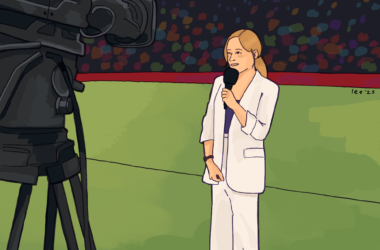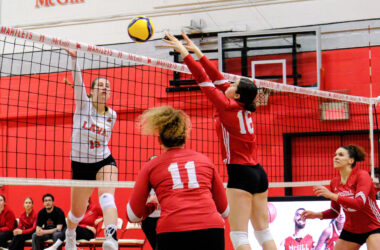Venus and Serena Williams’ ascent to stardom has transcended sports and moved into the forefront of popular culture. Serena recent appearance in Beyonce’s music video for “Sorry” demonstrates the extent to which the sisters have penetrated all facets of American society. While their supremacy is undisputed, it’s the sisters’ humble roots, hours of relentless practice, and their father–a man who wouldn’t stop pushing his daughters to greatness–that go largely unnoticed. In a form of poetic justice, their sibling rivalry transcended childhood practice to one of the most prolific tournaments in the world.
This past weekend, on Jan. 28, Venus and Serena battled one another for the Australian Open title, their first finals meeting since 2009. Ultimately, Serena won consecutive sets to claim her seventh Australian Open title and her 23rd Grand Slam—the most by any tennis player in history. However, after the match, she chose to speak about her closeness to Venus in both interviews and on social media, highlighting their sisterhood rather than their competitiveness. As such, revisiting their origins and their climb to winning Grand Slam titles is a cornerstone in understanding the impact they have had on their sport, on female athletics, and even on the politics of race relations in the United States.
Coming from modest beginnings, the Williams sisters father, Richard Williams, was the pair’s first and most influential tennis coach. Working as a sharecropper in his early years, he was drawn to tennis by the incredible amounts of money he noticed was exchanged after championships. Realizing the profitability of the sport, he decided that his two youngest daughters would become tennis players, but first, he had to teach himself how to play. Once he had a grasp of the game, he took his daughters to practice on the derelict tennis courts in Compton, California, where they spent countless hours working on tennis fundamentals. The time and effort put into the sport certainly paid off. By the time she was 16, though still unranked, Venus made it to the finals of her first U.S. Open. Serena soon followed suit, joining her older sister on tour and at some moments proving to be even more dominant.
The Williams sisters both leveraged and overcame their circumstances. Growing up in historically segregated areas of New York and California, their father asked passerbys to yell racial slurs to prepare them for competitions. Their upbringing motivated them to be better and more competitive, mainly to improve life for themselves and their family. Even when faced with racial abuse, most notably at the 2001 BNP Paribas Open in which the sisters and their father faced harassment from the crowd, the sisters maintained their competitive edge.
Over the duration of their careers, the sisters have been both one another’s greatest rivals and greatest supporters; perhaps being siblings fuels the sisters into optimal performance when playing each other. They have faced one another in 28 professional tournaments with Serena leading the meetings 17-11, yet off the court their competitiveness waivers and their sisterhood shines. Each one recognizes that without one another and their childhood competitions, they wouldn’t be where they are today.
Venus and Serena, with their sheer athleticism, rags-to-riches story, and close sibling relationship have brought new attention to women’s tennis. They’ve also made significant strides in breaking down the barriers keeping African-Americans out of tennis. Ultimately, the Williams sisters have left an awe-inspiring legacy on tennis, but they have also left a mark on women and black athletes in sports—making strides in changing social biases. Considering their age and Venus’ autoimmune disease, this may be the last time we see the two sisters taking each other on in a Grand Slam final, but their legacies in the sports world are sure to survive.
Coming from modest beginnings, the Williams sisters father, Richard Williams, was the pair’s first and most influential tennis coach. Working as a sharecropper in his early years, he was drawn to tennis by the incredible amounts of money he noticed was exchanged after championships. Realizing the profitability of the sport, he decided that his two youngest daughters would become tennis players, but first, he had to teach himself how to play. Once he had a grasp of the game, he took his daughters to practice on the derelict tennis courts in Compton, California, where they spent countless hours working on tennis fundamentals. The time and effort put into the sport certainly paid off. By the time she was 16, though still unranked, Venus made it to the finals of her first U.S. Open. Serena soon followed suit, joining her older sister on tour and at some moments proving to be even more dominant.
The Williams sisters both leveraged and overcame their circumstances. Growing up in historically segregated areas of New York and California, their father asked passerbys to yell racial slurs to prepare them for competitions. Their upbringing motivated them to be better and more competitive, mainly to improve life for themselves and their family. Even when faced with racial abuse, most notably at the 2001 BNP Paribas Open in which the sisters and their father faced harassment from the crowd, the sisters maintained their competitive edge.
Over the duration of their careers, the sisters have been both one another’s greatest rivals and greatest supporters; perhaps being siblings fuels the sisters into optimal performance when playing each other. They have faced one another in 28 professional tournaments with Serena leading the meetings 17-11, yet off the court their competitiveness waivers and their sisterhood shines. Each one recognizes that without one another and their childhood competitions, they wouldn’t be where they are today.
Venus and Serena, with their sheer athleticism, rags-to-riches story, and close sibling relationship have brought new attention to women’s tennis. They’ve also made significant strides in breaking down the barriers keeping African-Americans out of tennis. Ultimately, the Williams sisters have left an awe-inspiring legacy on tennis, but they have also left a mark on women and black athletes in sports—making strides in changing social biases. Considering their age and Venus’ autoimmune disease, this may be the last time we see the two sisters taking each other on in a Grand Slam final, but their legacies in the sports world are sure to survive.








